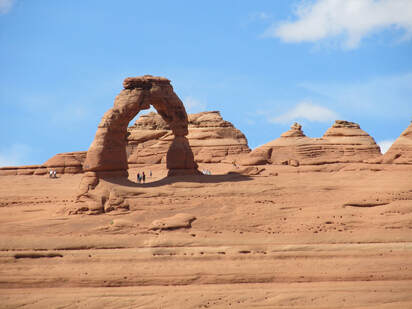The best “don’t miss” stops within the park include Balanced Rock, the Windows, Delicate Arch, and Devils Garden (listed nearest to farthest away from the park entrance and visitor center). No matter how short your visit, drive at least as far as the Windows section. Parking lots at these popular destinations can overflow during peak season, so you may have to visit them in a different order. Scenic photo opportunities start immediately inside the park, so keep your camera handy. Just a couple of miles from the entrance and visitor center (stop here first for an overview of the park) are viewpoints for Park Avenue, Courthouse Towers, Three Gossips, and several other picturesque rock creations. Early explorers often named these remarkable formations after things or places from “back home.” For example, an early traveler from the Big Apple thought the skyscraper-like monoliths looked like New York’s Park Avenue, hence the name. If some of this scenery seems familiar, it could be that you recognize it from Hollywood movies such as Ten Who Dared, Indiana Jones and the Last Crusade, Thelma and Louise and others. About nine miles from the entrance to Arches National Park is aptly named Balanced Rock— a mammoth boulder balanced precariously on a pedestal. If you want to stretch your legs, a very short hiking trail takes you to the base of this 128-foot tall fragile formation. Or save your steps and snap a photo from the road. From Balanced Rock, a side road leads to the Windows area where three massive arches make perfect frames for the landscape beyond. North Window is the smallest opening with a span of 93 feet and a height of 51 feet. South Window is 105 feet long and 66 feet high. Turret Arch actually has two openings, the largest of which is 64 feet high and spans 39 feet. A one-mile trail leads right up to these stone spectacles. Delicate Arch is probably the most famous arch in the park—it’s the iconic symbol found on just about every book, brochure, and guide ever written about Arches National Park. It is 46 feet high with a width of about 35 feet. Although on the small side, this arch draws scores of photographers, so the area is usually very crowded. You can admire this arch from a wheelchair accessible viewpoint (Delicate Arch is about three-quarter miles in the distance), or stand in its shadow after trekking three miles over mostly slickrock. There’s not a bit of shade along the hard hike, so it can be brutal in the summer sun. Needless to say, take lots of water and slather on the sunscreen! If you choose the three-mile Delicate Arch Trail, it begins at the Wolf Ranch parking area. In the late 1800s, John Wesley Wolfe, a disabled Civil War veteran, and his son, Fred, built a homestead here. A weathered log cabin, root cellar, and corral are all that’s left of the primitive cattle ranch they operated for about a dozen years. Peek inside—the cabin is listed on the National Register of Historic Places. A panel of petroglyphs near the ranch is thought to have been carved by the Ute Indians some time between A.D. 1650 and 1850. Many of the figures show stylized riders on horseback, and animals that look like sheep. Located at the end of the road that runs through Arches National Park, Devils Garden is not only the name of the campground, but also the name of a trail from which you can see eight arches, many backdropped by the snow-capped La Sal Mountains. Getting the most out of this area definitely requires lacing up your hiking boots. The sandy Devils Garden Trail (wearing trail running gaiters will keep sand out of your shoes and keep your socks cleaner) leads to Landscape Arch, the longest in the park, measuring 306 feet from base to base. It stands 106 feet high and at its thinnest point is only 10 feet thick. In 1991, a massive slab of rock fell from its underside, resulting in an even thinner ribbon of rock. Additional rockfalls occurred in 1995 and 1996. Along the trail you’ll also pass Pine Tree Arch, Tunnel Arch, and more. Just before Devils Garden is a viewpoint and short trail to elegant Skyline Arch. Skyline is of particular interest because it’s so young. It formed in November 1940 when a major rockfall doubled the size of what was then called Arch-in-the-Making. Skyline spans 69 feet and is 45 feet high. Although the Beehive State is home to five national parks, seven national monuments, and numerous state parks and historic sites, Arches National Park is one of Utah’s literal highlights. Perched at elevations ranging from 4,085 to 5,653 feet above sea level, the landscape here is classified as a high desert. That means temperatures in the summer and winter can be extreme, so it’s best to visit in the spring or fall. No matter what season you visit, you’ll find the greatest density of natural arches on earth surrounded by 119 square miles of scenery just waiting to be explored. The only arches you won't find here are the golden arches!Comments are closed.
|
RAZER GAITERS

 RSS Feed
RSS Feed
